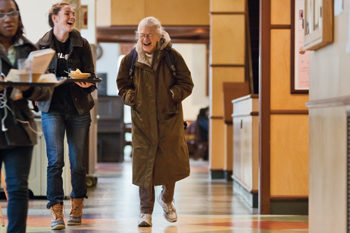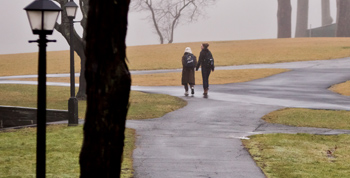Article by Caroline J. Hanna
Photos by Rob Mattson
[Courses] To see them eating a meal together, Kaitlyn McInnis ’13 and Amherst resident Gigi Green might seem like an odd couple: McInnis is 21 and Green is 88.

But the pair has many things in common. Both women are regular exercisers; Green frequents a gym in nearby Hadley and McInnis is a forward on the college’s hockey team. Both enjoy meditating. Both have deep interests in history, particularly World War II.
“The first time I met Gigi, I thought, ‘Here I am, having a conversation with someone who was 67 when I was born,’” McInnis said over a recent lunch with Green at Valentine. “But I quickly forgot about the age difference. She is so easy to talk to that we ended up chatting for hours.”
McInnis and Green became fast friends through “Psychology of Aging,” a course that delves into the behavioral changes that happen to humans as a normal part of the aging process. Taught by Lisa Raskin, the John William Ward Professor of Psychology, the class explores, among other things, diseases, perceptual and intellectual changes and the physiology of memory loss.
But students don’t just study the science. They discuss the myths, stereotypes and prejudices associated with growing older and examine aging through a cultural lens. Among the readings are Willa Cather’s The Professor’s House, D.L. Coburn’s The Gin Game and Leo Tolstoy’s The Death of Ivan Ilych.
Students are also paired with elderly members of the community, through a town initiative called the Friendly Visitor program. They spend time every week with the seniors, cooking, errand-running, reading aloud or just sitting and talking. This “helps the students put a face on aging,” Raskin says. “It also gives the students a healthy perspective on and strategy for growing old”—but without glossing over the realities. “The students do see life as it is,” Raskin says. “Sometimes the older participants are hospitalized. Once, someone died.”
Paul Vasconcellos, 64, has met eight undergraduates through the course. He has trimmed his Christmas tree with a student from Zimbabwe and comforted a Chinese undergraduate whose grandmother had been diagnosed with cancer. Once, when he was admitted to the hospital, a student visited. “Spending time with [the students] keeps me current,” he says, “and reminds me that I still have something to offer.”
Over lunch at Valentine, Green echoed those sentiments: “I learn so much from Kaitlyn, and I think she learns from me, too. You really get a feel for what’s going on in each other’s age group.”
“But you’re not a traditional 88-year-old, Gigi,” McInnis interjected. “She was just telling me how she went to the midnight premiere of Twilight with her [60-year-old] daughter and then went to the gym and an all-night diner.”
That Green is interested and able to participate in such activities has alleviated McInnis’ own fears about aging, which she developed while watching her grandmother struggle with dementia.
Visiting Green, McInnis says, has reinforced a message of Raskin’s course: that no two people age in the same manner. “There are some things I can control about growing old and some things I can’t. Meeting Gigi, though, has reassured me that, whatever happens in my life, if I have her positive outlook, I’ll be fine.”
